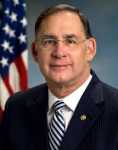- Supporting Americans with Disabilities and Their Families (3/6/25)
- Standing Up for Sportsmenís Access and Safety (2/20/25)
- Bringing Farm Country Voices to Washington (2/12/25)
- A New Front in the Fight Against Prostate Cancer (2/6/25)
- Taking Action to Reverse Immigration Failures and Protect Communities (1/30/25)
- Setting the Agenda for 2025 (1/22/25)
- Making progress for Arkansasís water infrastructure (1/16/25)
MKARNS: 50 Years Fueling Economic Growth
The U.S. Army Corps of Engineers’ largest public works project, the 445-mile McClellan-Kerr Arkansas River Navigation System (MKARNS), was completed 50 years ago this month. It’s important to understand how that visionary endeavor reshaped the region, creating a navigable waterway to serve the needs of the central United States and generating welcome economic benefits and job growth.
The MKARNS has had a tremendous impact on navigation, flood control, power generation, habitat conservation and economic development. As a river highway, it allows low-cost, fuel-efficient transportation for millions of tons of cargo each year, connecting people and goods throughout our country to the rest of the world.
This ambitious project helped tame rivers that were prone to highs and lows, at times experiencing extreme flooding and, for several months of the year, facing water levels too low for travel.
After the flood of 1927 destroyed 160,000 homes in seven states, Congress responded with the Flood Control Act of 1928 to authorize a program of flood works paid for by the federal government and create a comprehensive strategy for the Mississippi River and its tributaries. This was followed by the creation of the Southwestern Division of the Corps of Engineers in the Flood Control Act of 1936 and the 1946 Rivers and Harbors Act, which authorized the building of the MKARNS.
Thanks to the leadership and determination of the Arkansas and Oklahoma congressional delegations at the time, funding the MKARNS remained a priority for Congress. The members championed the value of this river corridor to America’s infrastructure and advocated for its completion over many years. I’m pleased that such support continues with our delegations today.
At the dedication of the completed waterway in 1971, President Richard Nixon noted the complexity and importance of the project when he stated “You have demonstrated once again the vitality of the American tradition of daring great things and achieving what we dare.”
Five decades later, the significance of the MKARNS continues to grow. In 2015, the U.S. Department of Transportation upgraded it to a Corridor on the National Marine Highway and the Corps increased its designation to a high-use waterway system. On average, 11 million tons of cargo worth more than $4 billion each year is transported on the MKARNS. The marine highway supports more than 56,000 jobs and provides an efficient method to transports goods and commodities.
Critical infrastructure like the MKARNS needs support to make sure it continues to meet the needs of our nation. That’s why I included language in the Senate Fiscal Year 2021 appropriations bill to highlight the importance of funding improvements such as deepening the channel so barges can transport heavier loads through the navigation system.
I will continue supporting policies to modernize the MKARNS and urging the Corps to prioritize funding for operations and maintenance. In fact, the Senate recently recognized the 50th anniversary milestone with the passage of a resolution led by senators from Arkansas and Oklahoma supporting the economic benefits of inland waterways system investments and commitment to complete the deepening of the MKARNS.
I am pleased to celebrate this anniversary and honor the work of the U.S. Army Corps of Engineers for creating and maintaining this tremendous asset. Its efforts continue to reap rewards as we all benefit from 445 miles of water and ingenuity that bring energy, safety and opportunity to our nation.
Posting a comment requires free registration:
- If you already have an account, follow this link to login
- Otherwise, follow this link to register

